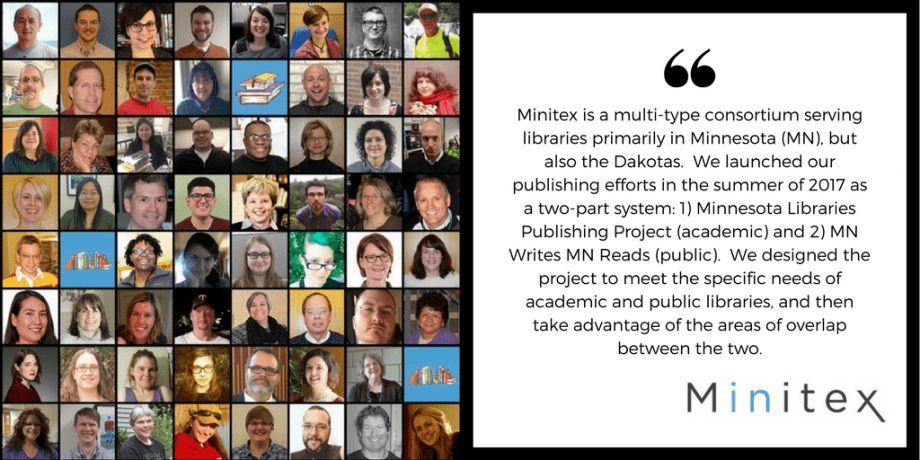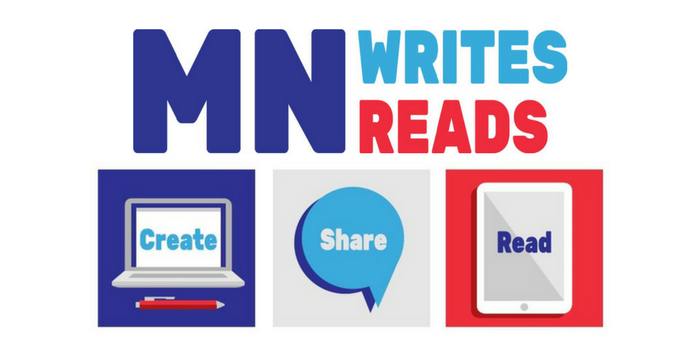As we gear up for the Library Publishing Forum and the start of a new membership year in July, we are publishing a series of member profiles. These profiles will showcase the wide variety of publishing work happening at member institutions, and celebrate our community’s contributions to the wider publishing landscape. Many thanks to the members who agreed to answer our questions! See all of the published profiles, and look for a new one each week until the Forum.
Tell us a bit about your publishing program.
Minitex is a multi-type consortium serving libraries primarily in Minnesota (MN), but also the Dakotas. We launched our publishing efforts in the summer of 2017 as a two-part system: 1) Minnesota Libraries Publishing Project (academic) and 2) MN Writes MN Reads (public). We designed the project to meet the specific needs of academic and public libraries, and then take advantage of the areas of overlap between the two.
The Minnesota Libraries Publishing Project (MLPP) provides a statewide instance of Pressbooks, an online publishing tool, as well as information sharing, training, and jointly-developed promotional materials for library staff. Our statewide version of Pressbooks is geo-authenticated, easy-to-access (e.g., does not require library ID), and is free of watermarks or any hidden costs. Our MLPP version of Pressbooks is being used by public, school, and academic libraries, and has seen a meteoric rise in use with 350 active authors in the nine months since we launched. We use Bibliolabs as our hosting vendor, and costs are shared by 20 academic libraries and Minitex.
MLPP also hosts a robust Community of Interest with over 30 academic libraries participating. Activities include frequent phone calls, workshop and conference programming, sharing of promotion and training materials, and peer advising to solve problems and help inform each library’s publishing practices. Academic librarians tell us that the ability to find and network with nearby peers has been one of the major advantages of MLPP.

The second linked project, MN Writes MN Reads, is funded by Minnesota’s 12 regional public library systems. This project uses Library Journal/Bibliolabs’ SELF-e system to onboard, build metadata, and circulate ebooks written by Minnesota authors. Bibliolabs created a direct link so that any book created in Pressbooks can be automatically uploaded into the Minnesota SELF-e author collection, called Indie Minnesota. Minnesota’s public libraries are making Indie Minnesota available on their websites and through their catalogs. The public library community has just launched a statewide self-published author contest to promote the system.
The following graphic represents the three parts of the MN Writes MN Reads publishing program: Create, Share, Read. The “Create” component provides access to Pressbooks. “Share” incorporates the Self-E onboarding and discovery system. And “Read” refers to the Indie Minnesota collection created by Minnesota authors and available statewide.

Tell us something you have accomplished with your program that you’re proud of – big or small.
Our biggest surprise has been how many authors are using MLPP’s Pressbooks instance since our launch last summer. We now have over 260 book projects underway with 350 authors. While we don’t have demographic data on our authors, accounts created in the system show that one-third have .edu addresses. We know that a significant number of textbooks are being created as well as fiction, non-fiction, children’s and YA literature, poetry, graphic novels, local and family histories, and every other category imaginable. Examples of some books in release or production are: 1) a Macalester College student created an environmentally-focused cookbook, 2) two librarians from Duluth are working on a compilation of the literature and art of Minnesota’s librarians, and 3) a retired professor from Gustavus Adolphus College is working on a local history of a neighborhood designed by the college’s faculty at the turn of the 19th century.
We have designed this program to be an experimental, innovative, learning experience. We know that Bowker sold more than 785,000 self-published ISBNs in 2017. We know that scholarly monograph, journal, and open-textbook creation is expanding; just look at LPC’s growth. What we don’t know, however, is what the long-term impact of these changes will be on how libraries acquire materials. One of our goals is to be proactive in learning how libraries should engage with local publishing during a time of disruption. We consider our work to be part of a profession-wide learning curve.
Looking ahead, what are you excited about, or what’s on the horizon for your program?
In less than a year our adoption rate has been surprisingly robust, and we anticipate significantly more growth. How large can we grow? We are also looking at adding an ISBN acquisition function for our authors and at methods of providing more Pressbooks support for authors. How we link in with the public library community’s November novel writing month (NANOWRIMO) is also under discussion.
Tell us about an obstacle you are facing in your work, or one that the field is facing as a whole.
We are internally debating a long-term goal: Should we be working to build permanent statewide collaborative structures, or should we be designing our systems to help build publishing capacity in local libraries? Larger systems, like the University of Minnesota or St. Paul Public Library, have well-established, sophisticated publishing programs. For our smaller academics and most of our public libraries, the bandwidth required to add in a library publishing infrastructure is a challenge. We are working through the process of finding the best mix of service and support.
Academic libraries are not eager to accept the self-published works of Minnesota authors into their catalogs or websites. The term ‘vanity press’ is often mentioned. We think they are underestimating the quality of the self-published works, and we hope to convince more academic libraries to offer Indie Minnesota as well as more academic authors to share their works in the system. Many academics may also not yet realize how much interest the public has in scholarly materials as we found in our statewide publisher-based system, Ebooks Minnesota.
We have many libraries contributing to our statewide publishing infrastructure. Will they wish to continue? If there is more budget pressure, will the newest thing—library publishing—be the first thing cut? Finally, the public and academic libraries are working together now, but will their interests and needs remain aligned as we mature and develop second-generation publishing support models?
Tell us about your experience participating in the community of library publishers. Has that experience influenced you or your work?
We are so new in this arena that we haven’t looked too far outside of the state to date. We have leaned heavily on the publishing experience of the University of Minnesota Libraries, Macalester College, Gustavus Adolphus College, and other Minnesota libraries that have experience in the field. Joining LPC was one way to bring more external knowledge into the state. Having the 2018 Library Publishing Forum conference on the University of Minnesota campus is a great launch pad for us in this effort, and we anticipate a large Minnesota contingent at the conference.
